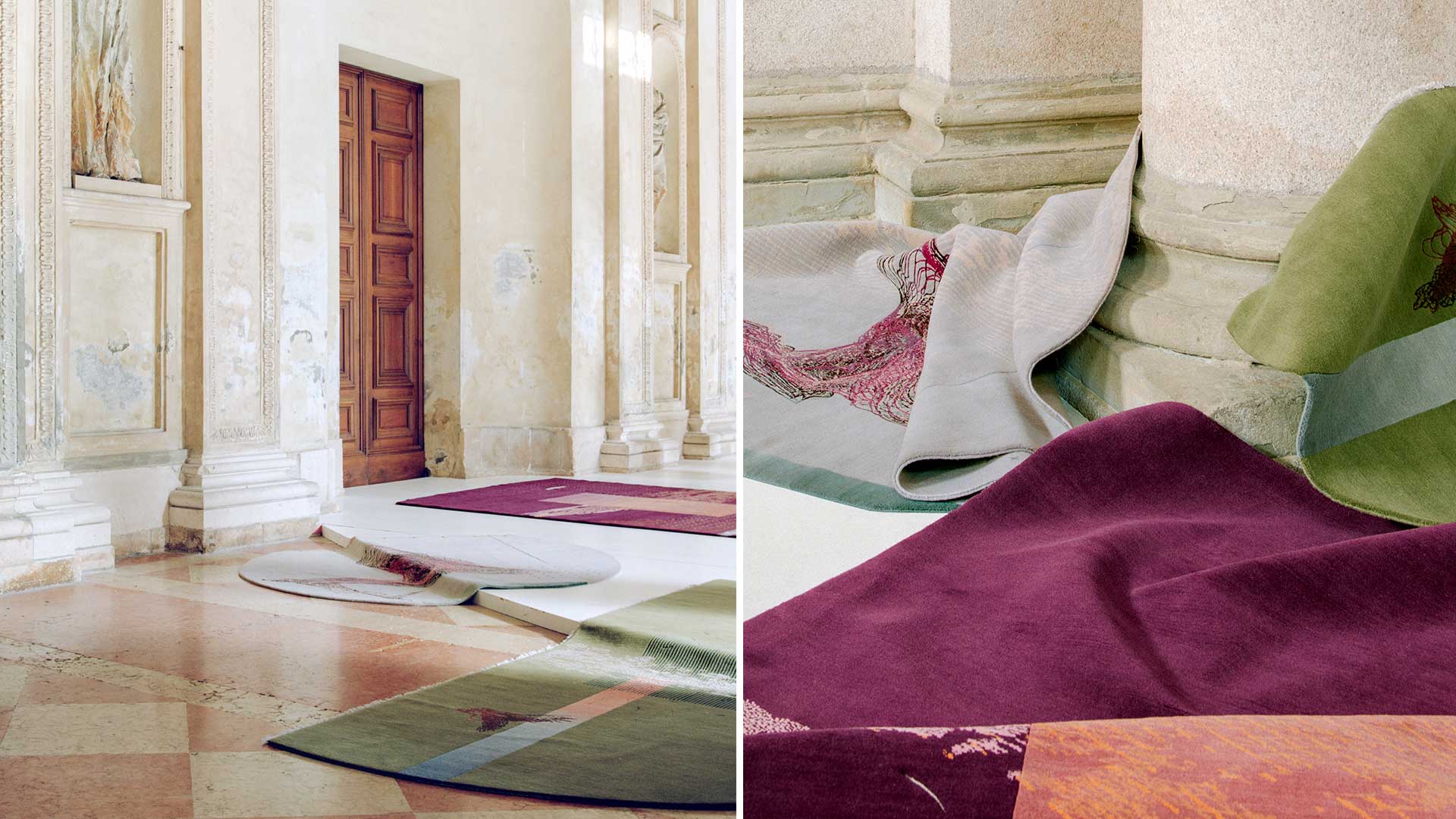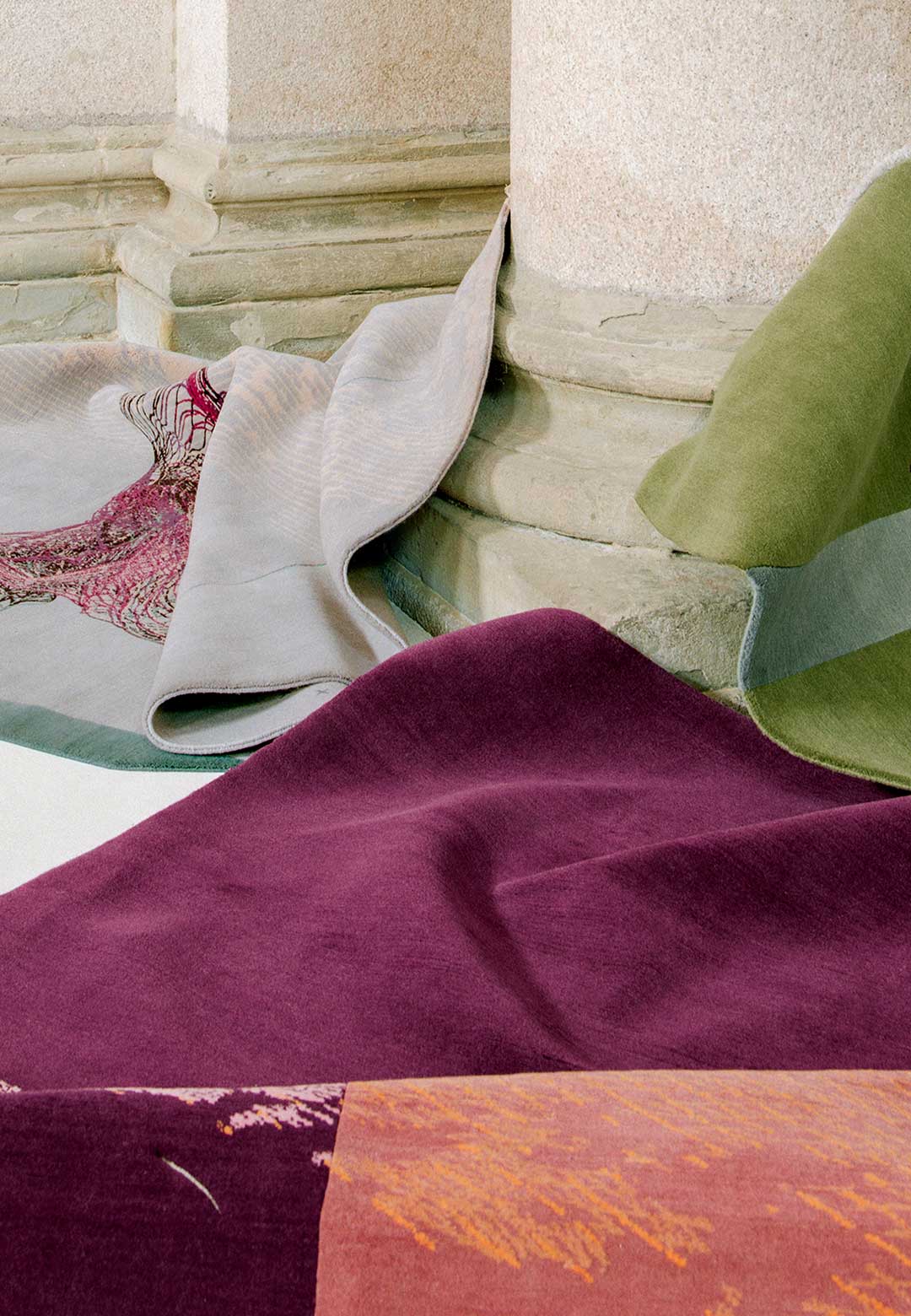In a world where cultures intermingle yet borders are intensified, the art of creating rugs, with each intricate thread and pattern, weaves together stories and experiences of generations past, of trauma, displacement, hope, and learnings, as manifested in the Impassable rugs collection designed by Milanese studio Scattered Disk Objects (SDOBJS). Every pattern, every vibrant hue, carries the weight of history, telling a story that spans continents and transcends time. The motifs etched upon the fabric embody the nomads' indomitable spirit, their unyielding will to adapt, and their eternal longing for a place to call home.
Exploring the theme of ‘freedom of movement,’ the Impassable rugs collection is inspired by ‘the vastness of the desert, and all the endless landscapes, where perhaps, it is more difficult to imagine a border, a barrier.’ The collection created for Nodus Rug comprises three limited edition, modest rug designs of different shapes and sizes, hand-knotted in Nepal, in wool and bamboo silk threads, and underscored by a belief that “rugs are deeply connected with stories of migration. Impassable imagines a language for the desire of freedom, comparing nomadism with the physical and virtual barriers of contemporary society,” according to the studio founders, architects Bahar Pourmoghadam and Marco Cattivelli (Iranian and Italian respectively).
"They travel with people and from generation to generation, turning into vehicles of communication and spreading ideas, forms, and technologies far away from where they have been fabricated. Their portability and the uniqueness of each piece made rugs commercial fortune,” they add.
With the Impassable rugs collection created with Tibetan knot techniques, the Italy-based studio considers the cultural significance of the carpet by “questioning the possibility of showing on rugs, the contradictions that regulate the movement of people beyond national borders—the carpet is a metaphor, evoking the origins of a tool in nomadic life, of distant people who had a rug for home and a tent for sky,” the product designers elaborate.
In a conversation with STIR, Pourmoghadam and Cattivelli elaborate on the concept articulating the Impassable rugs, and how these three limited edition carpet designs encapsulate the essence of migratory journeys, and the tenacity of those who embarked upon them.
Jincy Iype: How would you describe the Impassable rugs collection and how does it relate to nomadic life?
Scattered Disk Objects (SDOBJS): Drawings reinterpret the graphics of personal travel documents in comparison with the gabbeh motifs of the Persian nomadic tradition: a parallelism between two worlds—the intricate lines of the first analogue graphics, which is geometry and movement of cams and rosettes, and the meticulous work on the loom—where complexity translates into value.
Rugs are deeply connected with stories of migration. In the past and even now, nomads built their homes out of a rug and a tent, so they could relocate. Rugs also travel with people, from generation to generation, turning into vehicles of communication, spreading ideas, forms, and technologies, far away from where they were fabricated.
Jincy: Could you elaborate on the concept and inspiration for the limited-edition rugs?
SDOBJS: Rugs often symbolise the desires of those who make them. It is not surprising that traditional Persian carpets represented gorgeous gardens: oases of lush greenery are considered the ultimate prosperity in areas where water transportation is a major issue. So, the product design's basic concept was to employ a parallel metaphor to convey a desire—in this case, freedom—and the complexity of it in today's life, and then, transfer it to an intricate design, that ultimately translates into value.
Jincy: Could you highlight your creative process for the same?
SDOBJS: We spent months researching historic motifs and symbolism for this project, so when we came to designing, we already knew where we were going and how these carpets should look. We found a great partner in Nodus Rugs for the production of the three rugs. Andrea Galimberti, the brand's CEO, is well-versed on the subject and approached the job with an open mind. The carpets are handwoven in Nepal, where a manufacturing hub is now fully formed, with special care paid to the health and safety of the craftsmen.
Jincy: Could you elaborate on something you said—“The ‘Impassable’ collection explores the theme of freedom of movement” and “Carpets fly, those who make them don't”—within the context of this collection?
SDOBJS: By chance, or not, the production of these precious artefacts is almost always carried out by those who have greater difficulty crossing national borders. Morocco, Turkey, Iran, Afghanistan, India, Pakistan, Nepal, Tibet, and China are, in fact, both keepers of these artisanal processes, and the countries with the worst passports in the world.
A quality carpet is the result of long manual work, its value is often directly proportional to the meticulous work required to create it. It's still an object as exceptional as ambiguous: it seems out of place on the ground, yet equally unsuitable for the wall, yet, can belong to both.
Jincy: What inspired the shapes that the rugs are manifested in, as well as the reasons behind the employed materiality and colour palette?
SDOBJS: We attempted to employ a traditional Persian rug's colour palette in a certain detailed region of the rug rather than utilising it for the entire surface and keeping more fresh colours for the rest. In terms of the carpets' shape, we chose three major and classic carpet forms and subsequently reinterpreted these into new geometries. One of these shapes, which is less common yet majorly interesting, is the side carpet, which typically refers to carpets with a modest width but a significant length.
Jincy: How would you describe your design language and philosophy?
SDOBJS: The studio operates in the fields of object design, technology research, and small-scale architecture. We work in between industrial design and craftsmanship, with great interest in present and past manufacturing processes. For us, artisan production means embracing the process and acknowledging its value. The sense of a manual approach is also narrative, as the result contains further levels of meaning, personal and contingent.
Jincy: What is the reasoning behind your studio’s name? What is NEXT for you?
SDOBJS: The scattered disc is a region in our solar system where various rocky bodies orbit in odd trajectories: it seemed like a good metaphor for our various interests. We have many projects on the table. A series of partnerships with companies in Italy and Iran, and we just released Talar, a new collection of lighting fixtures in collaboration with a master glassblower from Venice.
As artistic testimonials, the muted knotted carpets also honour the courage of the displaced, while celebrating the richness of cultural encounters. Impassable, meticulously infused with narratives of migration and the nomadic spirit, beckons us to pause, to listen, and to cherish profound stories etched within its fibres. Within these pieces of contemporary design, tales of cultural fusion and encounters with foreign lands unfold. In philosophy, these rugs become more than mere floor coverings and décor pieces—they transition into vessels of memory, repositories of heritage, and conduits of human connection.






 Sign in with email
Sign in with email










What do you think?